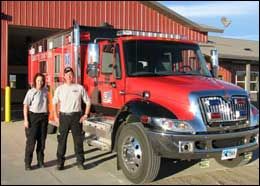By Bob Moen
Associated Press
Copyright 2007 The Associated Press
 AP Photo/Bob Moen Paramedics stand with a new ambulance outside the county’s new ambulance station Friday, in Wyo. Four oil and gas companies contributed $900,000 to help buy the ambulance. |
PINEDALE, Wyo. — Mike Becker works long days as a welder at a natural gas field so remote that the only light at night comes from scattered drilling rigs that operate 24 hours a day.
Becker used to worry about what would happen if he was injured. The nearest hospital is more than an hour’s drive away, and it can take more than 30 minutes just for the ambulance to arrive.
Now, with the help of four oil and gas companies, a specialized ambulance has been stationed near the fields, drastically cutting emergency response times.
“It’s good to have something like that out there, just being that much closer to where things could happen,” Becker said.
Many oil and gas fields around the world are located in remote areas like southwest Wyoming or on platforms far offshore. In the United States, companies are required to have people in the field who are trained to treat injuries, but accidents requiring emergency care can mean long waits for an ambulance or helicopter.
“It’s definitely a part of the oil and gas industry, but it’s definitely an aspect of rural life in general,” said Cliff Walker, chairman of a voluntary health and safety organization comprising energy companies in the region.
Recently, four companies — Shell, EnCana, Ultra and BP — contributed $900,000 toward the new ambulance and a place to house it. Sublette County chipped in an additional $500,000.
Stationed where two rural highways meet, the ambulance is within 10 miles of two of the most active gas fields in the state. While it used to take 30 minutes or more just to reach the entrance to the gas fields, it now takes less than eight minutes, officials say.
“It’s going to make a difference if anything happens out there,” said Wil Gay, supervisor of the Sublette County Emergency Medical Services.
Working in the oil and gas fields can be dangerous. Huge drilling rigs have moving parts that can snag clothing and rip off limbs.
“It’s not a business for folks who aren’t trained, and it’s not a business for folks not following procedures,” said Geoff Sell, an operations manager in southwest Wyoming for Shell Exploration & Production Co.
Sell estimated that, on any given day, about 1,000 workers are at the two Sublette County gas fields where Shell and other companies have operations.
Last year, four workers involved in oil and gas drilling died in Wyoming, according to the state Department of Employment. Nationwide, 35 such workers died. And an additional four workers in Wyoming and 67 nationwide died doing drilling support jobs, such as welding.
Besides the dangerous work, the dark, rural roads can be deadly as workers return home from a long day in the field.
In Wyoming, where the booming energy industry has outstripped the local labor supply, many rig hands are brought in from out of state and work 12-hour shifts for 14 straight days.
“There’s people who have heart attacks. There’s people who get in vehicle accidents,” Sell said. “All of those things, the length of the response time is important to the ability to survive an incident.”
The idea for the Sublette County ambulance arose about a year ago during a meeting of the Rocky Mountain Health, Safety, Environmental Council, which meets regularly to share information about safety issues and best practices.
“We need to find a way as an industry to provide better care for our workers,” said Walker, the council’s chairman, who oversees worker safety in the region for Weatherford International Ltd., a Houston-based oil and gas field services company.
The ambulance costs $217,000 and is bigger than most. It has more room in the back and a cab with three bucket seats. It also features a battery-powered extraction tool used to pry apart steel and a 30-gallon tank and fire hose to extinguish small fires.
The station has a kitchen, exercise area, TV with satellite service, bunkrooms, laundry facilities and other amenities.
The county covers the annual operating costs of nine full-time medics who staff the station around the clock.
In its first few weeks of operation earlier this fall, the station handled nearly a dozen emergency calls, including one in the nearby gas fields and five car accidents involving oil and gas field workers.
County officials applauded the proactive spirit shown by the four oil and gas companies. Shell’s Sell said competing energy companies are willing to work together on improving worker safety and health care.
“That’s something that people are pretty open to sharing,” he said. “Nobody wants to see anybody get hurt.”











